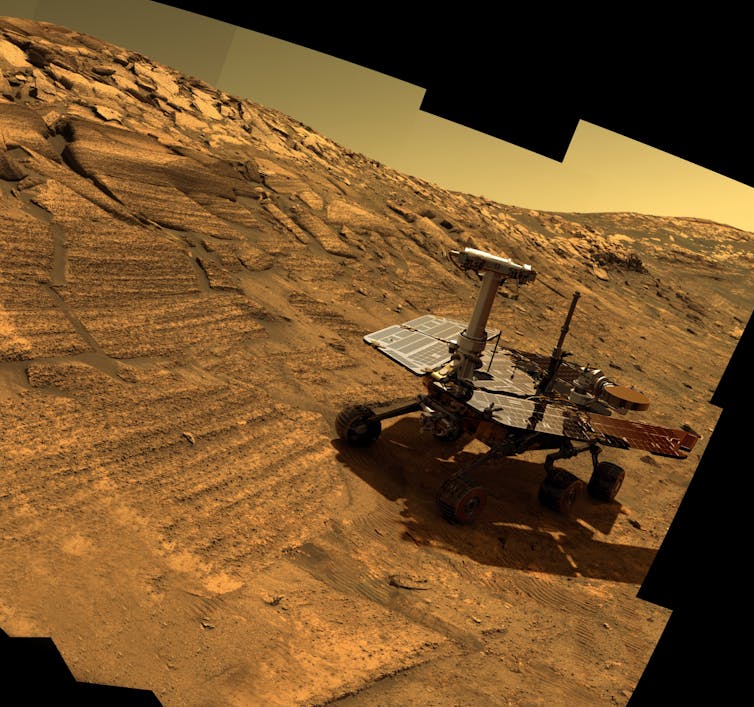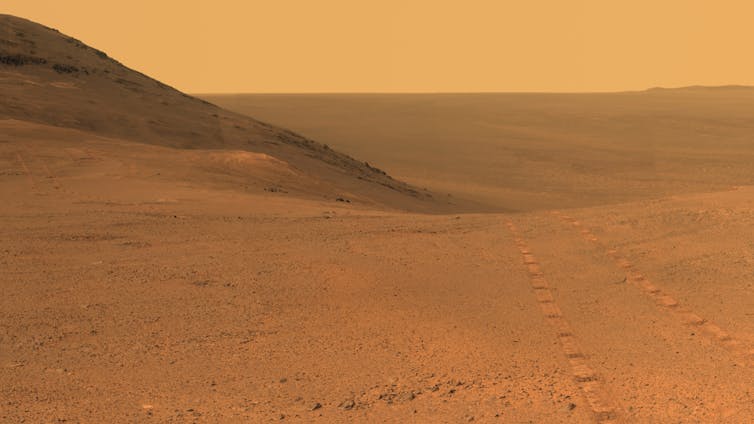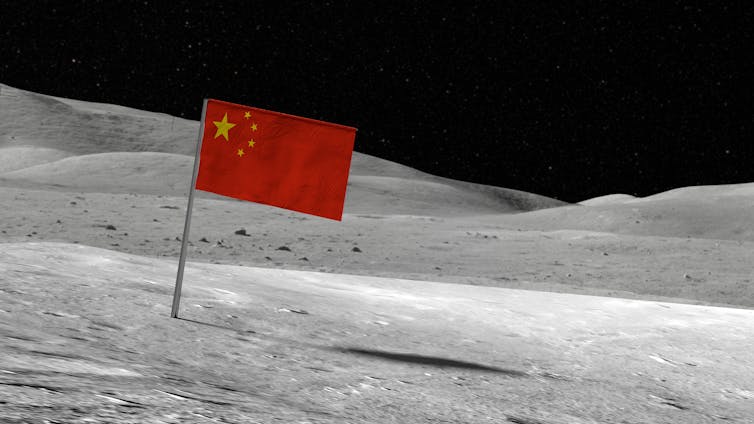
NASA’s Opportunity rover on Mars has been officially pronounced dead. Its amazingly successful mission lasted nearly 15 years, well beyond its initial three-month goal. Opportunity provided the first proof that water once existed on Mars and shaped its surface, a crucial piece of knowledge informing both current and future missions.
Opportunity landed on the red planet on January 25, 2004, and was last heard from on June 10, 2018, when a huge dust storm reduced light levels there significantly. This prevented the rover from using its solar panels to charge its batteries. The solar panels had already started to degrade due to the longer than expected mission, and the low light levels and the build up of dust may have caused its ultimate demise.
The rover has driven over 45km on the Martian surface despite being designed to travel for just 1km – an interplanetary record. Lasting almost 60 times its expected lifetime, it is an incredible achievement for space exploration. The mission is therefore helping scientists design new rover missions including NASA’s Mars 2020 rover and the ExoMars 2020 rover that I work on, recently named “Rosalind Franklin” after the DNA pioneer.
Stunning science
The science from the Mars exploration rovers Spirit and Opportunity has been simply groundbreaking. For Opportunity, it started with landing by chance in a 22-metre wide crater called “Eagle” on an otherwise mainly flat plain – a space exploration “hole in one”. Immediately after landing, it spotted a layered rocky outcrop, similar to sedimentary rocks on Earth but never before seen on Mars. And because it was mobile, it could actually examine the rock composition directly after leaving the landing platform.By illuminating the rocks with radioactive sources, the rover discovered the expected iron (effectively rust) that makes Mars’ surface reddish brown, along with other metals such as nickel and zinc. But it also found more volatile elements like bromine, chlorine and sulphur, which indicated that these rocks may have reacted with ancient water. Most excitingly, it detected the mineral “jarosite”, which is often seen in the outflow of acidic water from mining sites on Earth. This provided direct evidence that acidic water had been involved in the formation of Mars’ rocks 3.8-4 billion years ago.
The rover then moved out of the Eagle crater onto the flat, surrounding plain. In the first weeks, it discovered “blueberries” – millimetre-sized spheres of the mineral hematite. Although this could have formed due to volcanism or meteor impacts, analysis revealed that it most likely formed in water.
Opportunity later visited the spectacular Victoria crater, which is 750 metres in diameter and some 70 metres deep, with dunes on the crater floor. Remarkably, the rover and its tracks were imaged from orbit by NASA’s Mars Reconnaissance Orbiter near the crater rim. There was more hematite here, too, showing that this may have formed underground in water, before being brought to the surface when the crater formed via an impact.

Its next destination was the Endeavour crater, which is 22km in diameter and 300 metres deep. Here it also made a major discovery –- there were clays near the crater rim, which would have required fresh, abundant and non-acidic water for their formation. This was the first indication that Mars was actually habitable 3.8-4 billion years ago, containing drinkable as well as acidic water.
These main science results are key to our scientific exploration of Mars today. The question of habitability is being pursued further by the NASA Curiosity mission, which has already found evidence of a large, ancient lake on early Mars that contained organic matter by drilling into the mudstones that remain.
Digging deeper
Thanks to Opportunity, upcoming missions will look closer at the spots were ancient water flowed. NASA’s Mars 2020 rover will gather samples from Jezero crater, a location where orbiters have detected signs of an ancient river delta. These samples may be returned to Earth by a future international mission. Analysis in labs on Earth may ultimately answer the question of whether there is or ever was life on Mars, if we haven’t already.
Meanwhile, our Rosalind Franklin rover, a collaboration between the European Space Agency and Russia, is due for launch in 2020. It will land in March, 2021, at Oxia Planum, an elevated plain. Here, there are also signs of prolonged exposure to ancient water, clays and a river outflow channel.
Rosalind the rover will pick up where Opportunity and Curiosity left off by examining a key, unexplored dimension on Mars – depth. We will drill down to two metres below the surface of Mars for the first time, much further than Curiosity’s five centimetres. This is enough to take us far enough below the harsh surface environment of Mars – with cold temperatures, a thin carbon dioxide atmosphere and high levels of harmful radiation – to see if anything lives there.
We will decide where to drill using a number of instruments, including the PanCam instrument which I lead. Samples will be vaporised and put into a drawer for analysis by three instruments which will look for markers of life – such as complex carbonates.
One of the key aspects of Opportunity’s success was the teamwork between its science and engineering teams. This is definitely something that will be implemented on upcoming rovers. Many members of the Mars 2020 team, and some on the ExoMars team, have direct experience from Opportunity which will be invaluable as we learn how to operate our rovers on the planet.
Another interesting legacy of Opportunity is that we we don’t have to worry too much about Martian dust, except during exceptional global storms. Opportunity showed that that during the rest of the time, accumulating dust blows away naturally in the wind – helped by the movement of the rover over the ground causing vibration. It was a surprise that Opportunity lasted so long, and it certainly blazed a trail for us.
Rosalind Franklin has the best chance of any currently planned mission for detecting biomarkers and even perhaps evidence for past or present life on Mars. But we are building on the shoulders of giants, like the Opportunity Rover. #ThanksOppy indeed!
Andrew Coates, Professor of Physics, Deputy Director (Solar System) at the Mullard Space Science Laboratory, UCL
This article is republished from The Conversation under a Creative Commons license. Read the original article.











